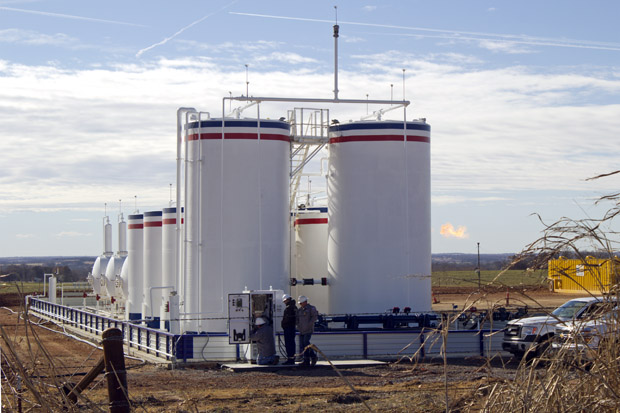
Oil-field workers tend to American Energy-Woodford's Judge South well in November 2014 well shortly after the Oklahoma Corporation Commission ordered it temporarily shut-in.
Joe Wertz / StateImpact Oklahoma


Oil-field workers tend to American Energy-Woodford's Judge South well in November 2014 well shortly after the Oklahoma Corporation Commission ordered it temporarily shut-in.
Joe Wertz / StateImpact Oklahoma

Joe Wertz / StateImpact Oklahoma
Oil-field workers in November 2014 tending to American Energy-Woodford's Judge South well near Perkins, Okla., shortly after the Oklahoma Corporation Commission ordered it temporarily shut-in.
As earthquakes continue to rattle Oklahoma and scientists study links to oil and gas production, many Oklahomans want to know what, if anything, is being done to address the shaking.
An investigation by StateImpact shows that while authorities are quietly scrutinizing wells in quake-prone parts of the state, most of the companies that operate the wells are staying silent.
Marla’s Salon looks like a little house. It has a fence and a yard and a collie keeping watch at the door. Inside, the owner, Marla Stevens, snips and blow-dries. There’s buzzing in the salon, too, including clatter from hair clippers and chatter about earthquakes.
Marla’s Salon is six miles south of Stillwater in Payne County, which is now earthquake country. The salon and the real house behind it, where Stevens and her husband live, sit atop a geological formation called the Arbuckle, which has recently come alive with earthquakes.
Even though most of the quakes are minor — in the magnitude-2.0 or -3.0 range — Stevens says they don’t feel small. A 3.8-magnitude quake that struck here in November 2014 knocked all the bottles of dye off the shelves.
“They all fell down,” Stevens says. “And my angel fell off the wall — and her head fell off.”
More than 560 magnitude-3.0 or larger earthquakes were recorded in Oklahoma in 2014, more than twice as many as California and the most among any state in the Lower 48.
Scores of peer-reviewed scientific papers suggest much of the shaking has been triggered by disposal wells that the energy industry pumps full of waste fluid, a byproduct of oil and gas production.
Stevens’ husband, Roger, says he believes the wells are a contributing factor in at least some of the shaking.
“I want to know if it being caused by the oil companies or not,” he says. “If it is that, they need to do something about it.”

Joe Wertz / StateImpact Oklahoma
Marla Stevens at her salon south of Stillwater, Okla.
The Oklahoma Corporation Commission, the state’s oil and gas regulator, enacted stricter monitoring requirements for disposal well operators in 2014.
Other states — including Arkansas, Colorado, Texas and Ohio — have reported earthquakes that seismologists say were likely triggered, or “induced,” by disposal wells. Many of those states were more aggressive than Oklahoma in responding with formal rules.
The Corporation Commission, however, has revised its permitting process to scrutinize disposal wells and their operators.
The commission has defined “areas of interest,” wherein concentrated seismic activity warrants extra review of both proposed and existing disposal wells.
If approved, new disposal wells within six miles of the epicenter of a 4.0-magnitude or larger earthquake, or within two miles of faults designated by the Oklahoma Geological Survey to likely be under the most stress, are issued “traffic light” permits.
The exact language differs from well to well, but these temporary, six-month permit often limit well pressures and injection volumes. They also define a “red light” condition, in which a significant increase in earthquake activity triggers a well shutdown.
For existing wells, a magnitude-4.0 earthquake alone prompts a review of every disposal well operation within six miles.
“We’re systematically looking at all these wells, especially the ones in the areas where we’re having seismicity, and we’re seeing if they were completed in strict compliance with their permit,” says Tim Baker, director of Oklahoma Corporation Commission’s oil and gas division.
While scientists still are trying to understand what combination of geologic features and disposal well parameters are most likely to trigger earthquakes, there is wide consensus on several factors that appear most risky. One factor is disposal wells that are drilled into basement rock, the hard layer of granite underneath oil and gas deposits.
“That’s the highest risk scenario we can get into if we’re looking for the possibility of disposal wells generating pressures on faults,” Baker says.
Injecting waste fluid near critically stressed fault lines is another big risk factor. Baker says the commission is working with the state Geological Survey and other scientists to better map Oklahoma’s faults.
The Corporation Commission’s permit scrutiny has led to regulatory sanctions — known as directives or orders — of at least 18 disposal wells in earthquake-prone regions, a StateImpact examination of well records and documents obtained through Open Records Act requests show.
Among those, six were ordered to temporarily shut down or to slow or cease waste fluid injection.
StateImpact contacted the companies that operate the wells — American Energy Partners-Woodford, Bosque Disposal Systems, B.R. Polk, B&W Operating, Devon Energy, Pedestal Oil, Petro Warrior, RC Taylor Companies, Red Fork Energy and Spess Oil Company — to find out what, if anything, they were doing to monitor and minimize the risk of earthquakes.
Most of the companies didn’t reply or declined StateImpact’s requests for comment. Denver-based Sundance Energy was the only company that agreed to an interview.
“We’ve done a lot of extra work and spent some money and time to help with the commission in this particular area,” says Jim Nondorf, a geologist with Sundance’s Oklahoma operation.
Even though the earthquake activity started before Sundance’s Conforth disposal well in Logan County had gone online, Nondorf says Sundance supplied the commission with drilling logs and extra data.
“We showed them everything, and they came back and said we were compliant in doing everything that we were supposed to do. One-hundred percent compliance,” Nondorf says.
Most of the other companies that were issued orders after quake-related inspections are suspected of drilling into basement rock, records show. Those companies can provide logs and data that prove otherwise, or they can pump in cement to reduce the well’s depth, the Corporation Commission’s Baker says. If they don’t, Baker says they won’t be allowed to continue using the disposal well.